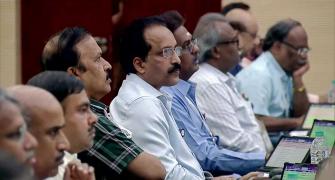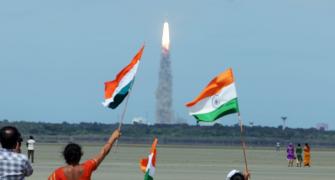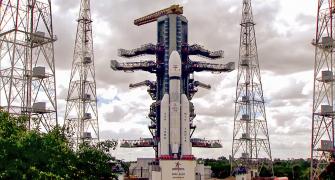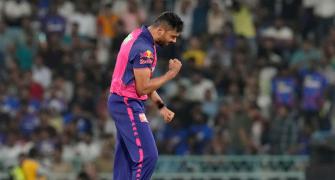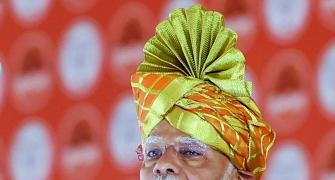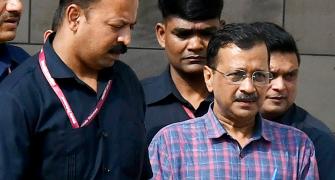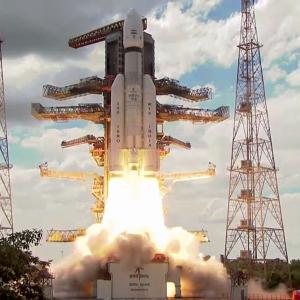'ISRO takes a very cautious approach.'
'After reaching the moon, the orbit has to be brought down from a single elliptical orbit to a circular orbit while simultaneously ensuring the stability of Chandrayaan 3 and the health parameters of the lander and rover.'

G Madhavan Nair, former chairman of the Indian Space Research Organisation, explains to Prasanna D Zore/Rediff.comthe significance of Chandrayaan 3 for India's space programmes, how the vehicle will enter into the moon's orbit in different stages, what intricate manoeuvres the spacecraft and the lander and rover on board will undertake to make the mission truly successful.
How significant is the success of Chandrayan 3 for India's space programme?
Chandrayaan 3 is going to be a very major turning point as far as the Indian space programme is concerned. The planetary exploration -- the Gaganyaan Mission -- is very much on the agenda of the Indian space programme.
As part of that (the Gaganyaan Mission) Chandrayaan 3 is a major step towards demonstrating India's capability to land safely on another planet and collect samples and conduct experiments; it's not only going to prove our technologies, but also provide a lot of scientific information about the dark side of the moon.
So Chandrayaan 3 is especially programmed to explore the moon's South Pole?
Yes, definitely. Because actually in earlier missions -- Chandrayaan 1 and Chandrayaan 2 -- we had said that the southern part of the moon has got huge deposits of ice and also this region is more or less in an emerging state because the solar radiation and other things affect that region.
And the ground conditions (on the moon's South Pole) are more or less same as what it was about 4 billion years ago when the moon was born.
We will get a lot of idea about the origin of the moon itself and the planetary system. More than that, it is a validation of capabilities of some of the remote sensitive parameters in the earlier missions.
Chandrayaan 2 was a near success I would say and it met two of the major objectives. One is to have the orbiter with a complementary set of instruments for observation (in the moon's orbit) and then the lander and rover which were supposed to have a soft landing on the lunar surface.
The mission went off perfectly well, reaching the moon and putting the orbiter around the moon and so on.
Later, when they attempted the landing operation the trajectory to land on the moon was precisely followed up to about 2 km above the lunar surface. At that instant, some breaches happened in the system and that resulted in the landing vehicle (Vikram) losing control and impacting with a fairly high velocity on the lunar surface.
So to that extent it was not successful but at the same time, all the technologies to enter the moon's orbit and then try to descend towards the moon's surface have been demonstrated in the previous missions.

Could you explain to our readers the phases of Chandrayaan 3 and how will it reach the moon in stages?
First of all, the mother rocket like the GSLV (Geosynchronous Satellite Launch Vehicle) places itself in a highly elliptical orbit around the earth. From then onwards, it is a propulsion module which is on the spacecraft which takes over.
The orbit is raised step by step by firing of four or five thrusters and later the entire Chandrayaan is shot out of the earth's orbit like a catapult throws a stone over long distances (without much effort).
The vehicle then moves towards the moon in a planned trajectory and as it approaches the moon the spacecraft's speed has to be reduced. Again, the thrusters will be operated and the speed will be reduced to the required extent.
With that speed the moon can pull the spacecraft into its orbit, which is again elliptical and then again some thrusters are fired to get Chandrayaan enter into moon's circular orbit step by step.
Once the circular orbit is established around the moon, the orbiter detaches the lander from the mother spacecraft and makes it follow a trajectory preparing the lander for a soft landing.
Here again, the velocity of the lander is reduced compared to the orbit module and then again, thrusters are used for precisely controlling the lander's orientation as well as countering the gravitational pull of the moon.
To that extent, it is a very precise operation and it is done in a blind manner, so to say.
The instruments on board (the lander) react to the data (of the surrounding environment on moon), the stereoscopic cameras, laser ranging system and the onboard computer and everything is autonomous because on the ground it is not possible to control the communication time.
To overcome this challenge, the entire operation is automated. And once you land on the surface, the entire thing has to follow a predetermined programme.
The moon's gravitational pull is one-sixth that of the earth. What kind of manoeuvres will Chandrayaan 3 have to make when it enters moon's orbit to sync with this change?
The orbital velocity has to be precisely controlled so that the centripetal force as well as the gravitational pull of the moon will be balanced. That is one thing which is done at the injection stage.
For breaking away from the moon's orbit, its (the lander's) velocity has to be reduced further.
But then, unlike on earth, to overcome the (earth's) atmospheric drag the propulsion modules need to generate huge velocities, whereas on the moon there is no atmosphere. So that means negative acceleration.
The net result is the speed of the spacecraft during the entire operation has to be controlled by the propulsion system dynamically.
The negative acceleration or the deterioration (in the speed of the spacecraft) has to be in such a way that the propulsion module will balance the pull of the moon and produce only a low velocity of about 1.6 kilometres per second at the time of detachment (of the lander from the propulsion module) and generate a velocity of less than two metres per second at the time of landing so that the lander doesn't crash land on the lunar surface.
To that extent, a precise control trajectory needs to be implemented while descending.

What are the roles of the orbiter, lander and the rover?
As far as Chandrayaan 3 is concerned the orbiter has only got communication and control equipment on board along with the propulsion system.
In Chandrayaan 2 there were hosts of instruments for remote observation of the moon as well. This time too, the same module will be active and used for complementary scientific observations as well as relaying the data from the rover.
In that sense, Chandrayaan 2 is complementary to Chandrayan 3 to a great extent: the descending module -- again a separate propulsion module -- the on board computer, sensors and everything.
The rover (the vehicle that will actually roam the moon's South Pole and relay data) is a six-wheeled autonomous vehicle which can move around the surface of the moon and carry out the (pre-programmed) experiments.
There are X-ray detectors, gamma detectors, etc to look at the (lunar) surface; then there's also the spectral imaging system to measure the temperature profile, and seismic sensors and so on.
This spacecraft is designed to operate over one lunar day -- that is 14 days on the ground -- and collect the data in the nearby region and relay to us including the pictures of the lunar surface.
How many days would Chandrayaan 3 take to land on the moon and deploy the lander and rover to explore the moon's South Pole?
As per the plan around August 23 the landing operation will be attempted and after landing there it is planned to have 14 days of operation on the surface of the moon.
Right now (as on July 20) the spacecraft is still in the earth's orbit and by about the end of the month or August beginning it will be shot towards the moon. Other surface operations will start from then onwards.
Chandrayaan 2 did land on the moon. Why did the lander Vikram crash and why couldn't it deploy the rover Pragyan?
As I told earlier, up to two kilometres altitude (from the moon's surface) it went on very well. By the time the speed was something like 100 kilometres per second which was later reduced to two metres per second for the rover to land softly on the lunar surface.
Now, at this high velocity (of 100 kilometres per second) the orientation was lost and the entire spacecraft tumbled and fell freely on the moon. So the shock level is very high and that shock level will disintegrate the entire spacecraft (lander).
Why would Chandrayaan 3 take so many days? It was launched on July 14 and it will likely attempt the landing on August 23?
Basically, ISRO takes a very cautious approach. The orbiting around the earth is a step by step process using the propulsion module and at every stage the system is calibrated for its performance so that you can arrive near the moon precisely and safely.
Then after reaching the moon also the orbit has to be brought down from a single elliptical orbit to a circular orbit while simultaneously ensuring the stability of Chandrayaan 3 and the health parameters of the lander and rover.
All these stages are sequenced in a systematic manner so that at every stage the data is analysed and confirmed before going to the next step.
What are the biggest challenges for Chandrayaan 3 during its journey to the moon's orbit and subsequent soft landing of the rover on the moon?
The next critical moment will be the lunar capture (as Chandrayaan 3 was already orbiting around the earth as on July 20) which will happen in the first week of August or so.
If we shot from the earth's orbit, we will be having a free flight. In case this velocity is not precisely controlled at the exact time, it will simply fly off into deep space.
So just tracking the spacecraft and initiate precise commands at the right instance, giving the propulsion module right commands to precisely vary its velocities as required would be very crucial challenges.
Once that is done, the moon (the moon's gravitational pull) will capture the spacecraft and it will (orbit) around the moon safely. Then you can comfortably do the other operations.
The next big challenge after that is going to be the soft landing process. As I mentioned, the lander has undergone a series of modification based on the different reviews, a large number of simulations and so on.
There will always be some unknowns, but our scientists are well equipped to handle any challenges that we may encounter.
As I mentioned earlier, it is a blind operation and you cannot do anything from here (on the earth); onboard computers and sensors will have to do the job. The software has to function properly and I hope that there will not be any disturbance beyond the acceptable limits of what is designed.
Why is soft landing on the moon such a big challenge?
As I mentioned earlier, if you go with the higher speed, the impact velocity and shock will disintegrate spacecraft and damage the infrastructure. It is just like placing a child on a cradle. So you have to virtually cradle the spacecraft above the surface of the moon and slowly bring it down using the control.
What is the Slingshot method? What are its advantages?
For planetary mission there are few different methods and Slingshot is one of the methods.
Basically what happens is once you get out of the earth's gravitational field, it is almost a free flying object. Of course, it is influenced by the (gravitational) pull of the moon, other planets, the sun and so on, and that extent some disturbance will be there.
But (with the Slingshot method) you keep on travelling with the same speed to any distance and you don't require any extra energy or fuel after leaving the earth. But at the same time the moon is moving, the earth is rotating and also revolving.
So with all this combination of parameters to precisely chalk out the direction in which the Slingshot has to be made is crucial.
Of course, India has demonstrated this capability during the last three missions -- the two Chandryaan missions and the Mars Mission -- by using the same sequence of operations.
How will Chandrayaan 3 help India launch Gaganyaan -- India's first manned mission to space?
The Gaganyaan mission envisages carrying three human beings, inside a capsule, into the space and safely bringing them back to earth. That is the mission objective of Gaganyaan. That will be our first step towards sending a man to the moon. If you want to go to the moon much bigger rockets, much bigger capsules are required; lot of fuel is actually carried from the ground and so on. That is the next logical step.

